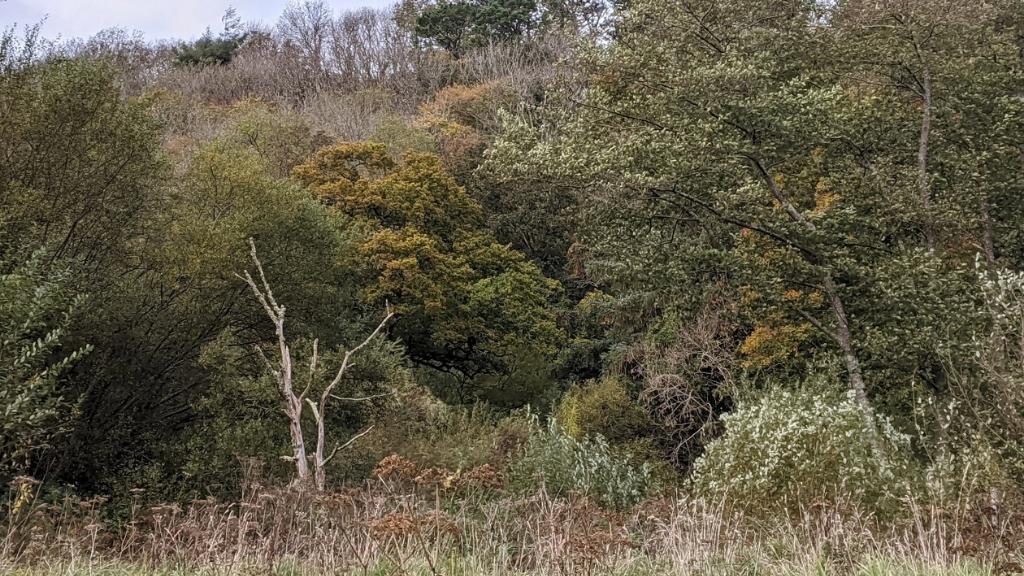Stephan Harding reflects on the rewilding of Berryman’s Marsh
Ecologist and Schumacher College Research Fellow, Dr Stephan Harding reflects on the decision to rewild a large stretch of land along the River Dart 30 years ago and the benefits to wildlife we can see there today.

Berryman’s Marsh looking towards Dartington Hill woods
Just over thirty years ago, in early october 1990, I packed my few possessions into my beaten up old car and drove down to Dartington from Oxford to take up my new position as Resident Ecologist at Schumacher College, which I helped to found at that time along with Satish Kumar and other colleagues. In that same month I was also appointed as the Estate Ecologist, charged with the ecological restoration of the Dartington estate. In this capacity I planted corridors of native trees to connect up previously isolated woodlands such as Chacegrove and Nellie’s woods, helped to create an otter sanctuary along the river, restored hedgerows and, amongst other things, tried to shift the farming in more ecologically friendly directions – the latter with only a modicum of success.
One of my proudest achievements as Estate Ecologist was the conversion of Berryman’s Marsh, a small field opposite the Lodge on the lower drive at the entrance to the estate, from a very dull rye grass monoculture for grazing cattle into a vibrant little patch of wilderness by the River Dart. It all happened by chance during the summer of 1992 when I happened to be cycling past Berryman’s Marsh and saw a huge bulldozer scraping away the topsoil as part of the laying of a big new pipeline across the estate and into Totnes.
Most conventional agricultural grazing land has been dosed with chemical fertilizers to encourage the growth of rye grass. Berryman’s Marsh was no exception. The rye grass takes up fertilizer faster than other plants which therefore can’t get a foothold and are thus excluded from the ecological community. The best way to establish wildflowers on a heavily fertilized field is to scrape away the topsoil, so you can imagine what went through my mind when I saw what was happening at Berryman’s Marsh that day. Right away, I got in touch with my superiors at the Trust and explained that a golden opportunity had just appeared to rewild a little part of the Trust’s extensive land holdings. They agreed, and the rewilding of Berryman’s Marsh became a reality. There was only one more thing to do. I rushed into Totnes and bought a nice bottle of whiskey. Rather than drinking this with my friends in celebration, I offered it to the bulldozer driver who in exchange dug two nice ponds in the Marsh to help boost its biodiversity. Later that summer, along the road by the Marsh, my wife Julia Ponsonby and I planted a row of little willow wands, now grown into huge stately willow trees.
The biodiversity in Berryman’s Marsh recovered beautifully, with great sprays of purple loosestrife, meadowseet and many other flowering plants in summer, managed by careful cutting in the autumn. But the Marsh isn’t just beautiful – its dense network of roots holds back rainwater and helps to prevent flooding downstream in Totnes. I hadn’t visited the Marsh for a while, but I went there in late October last year to take a look. I was delighted by what I found – a truly wild place near a busy main road, with a major railway line and a a humming industrial estate not far away. As I stood in the Marsh looking north towards the Dartington Hill woods I was transported back in time to an earlier England, to a beautiful Neolithic England in which large mammals roamed the land creating patches of immensely biodiverse scrub such as our restored Berryman’s Marsh interspersed with tall native woodland like that gracing the hill in front of me. Inspiration dawned. What if we could re-wild the entire boundary of the estate along the river Dart using breeds of horses, pigs and cattle resembling the original Neolithic megafauna of this area? We could then take paying guests on walking safaris along the river to enjoy the vibrant wildlife at all times of year, thereby helping to make the estate not only carbon neutral (rewilded areas store lots of carbon in their soils), but also financially viable. What if this new expansive rewilding project on the estate became part of a much larger River Dart Ecological Corridor running from Dartmoor to the Dartmouth where rewilded areas such as Berryman’s Marsh integrate beautifully with food growing zones such as those created at Schumacher College by Jane Gleeson, Colum Pawson and their amazing team of growers? Wouldn’t this show the way towards a truly Gaian society in which Western culture at last returns to harmonious living with nature? Isn’t this what Dartington should be doing at this time of severe global ecological crisis? Isn’t this what Tagore and the Elmhirsts would want those of us entrusted with this marvellous estate to do now? Couldn’t this kind of enlightened land use become a foundational endeavour of Dartington Learning? Let’s use what Berryman’s Marsh has taught us to convert the entire heartland of the Dartington Trust’s estate into the beating heart of the ‘River Dart Ecological Corridor’ – an example to the world of pioneering deep ecological education in which students and staff live a many sided life deeply embedded in the gentle agri-rewilded hills and meadows of this little corner of Devon.
Written by Dr Stephan Harding, Deep Ecology Research Fellow at Schumacher College
Berryman’s Marsh is one of many examples across the Dartington estate through which we as an organisation are exploring ecologically-minded, regenerative approaches to land management, food production, culture and conservation. To find out more about our conservation work, regenerative training and courses click the links below.

Dr Stephan Harding
stephan.harding@schumachercollege.org.uk
Stephan is a Deep Ecology Research Fellow and has been teaching on the MSC Holistic Science programme since its inception in 1998.
